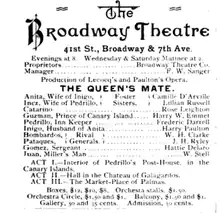Camille D'Arville
Camille D'Arville (June 21, 1863 – September 9, 1932), born Cornelia "Neeltye" Dykstra, was a Dutch-born light opera singer and a vaudeville performer. She was a member of The Bostonians. (Her surname is also found as Darville, d'Arville, and D'arville.)

Early life
Neeltye Dykstra was from the province of Overijssel the daughter of Cornelius Dykstra, a merchant.[1] She studied music in Amsterdam, where she made her concert debut at age 14, and pursued further training in Vienna. She changed her name to Camille D'Arville soon after her opera debut in London.[2]
Career
.jpg.webp)

In London D'Arville was associated with the Gaiety Theatre; she appeared in the shows La Vie, Chilperic, Rip Van Winkle, Falka, Mynheer Jan, Carina, and Cymbria, among others. She moved to the United States in 1888.[3] Her stage appearances included roles in The Queen's Mate (1888), Venus (1893), Oscar Hammerstein I's Santa Maria (1896), The Belle of London Town (1907), A Daughter of the Revolution, The Bohemian Girl, Robin Hood, Madeleine, The Highwayman, and The Mascotte.[4][5] She was associated with the Bostonians light opera company for some of these shows.[2] She was known for "cavalier" parts, in which female characters were disguised in masculine hat, tunic, boots, and tights for part of the show.[6]"She wears a military costume which is charmingly becoming to her, also a short curly blond wig," one reviewer noted.[7] In 1894, she headed the Camille D'Arville Light Opera Company.[8] She retired from the stage after 1908, though she had announced an intention to retire after her second marriage as early as 1900, writing "I believe that any other woman who pursues a profession after her marriage makes a miserable failure of it."[9]
Later in life, she worked behind the scenes with the Reginald Travers Company, as a financial patron and artistic advisor.[10] She also purchased a large prune ranch near Los Gatos, California, in 1913.[11] During World War I she was president of Stage Women's War Relief branch in San Francisco.[12][13] She was also president of the San Francisco Light Opera Company.[14]
Personal life
Camille D'Arville married twice. Her first husband was Andrew Wilson Lyons, an acrobat. They married in 1879 and divorced in 1899.[15] She married businessman Ernest Willard Crellin and lived in San Francisco, California in her later life.[16] She died in 1932, aged 69 years, in San Francisco. She was survived by Crellin, by her son Louis Lyons Wilson, and by her sister Lena Dykstra.[14][17]
References
- A. D. Storms, The Players Blue Book (Sutherland & Storms 1901): 242.
- "Camille D'Arville" Grande Musica.
- "Camille D'Arville's Arrival", The New York Times (April 2, 1888), p. 8.
- Marwell Hall, ed., Gallery of Players from the Illustrated American (Lorillard Spencer 1895): 40-41.
- Johnson Briscoe, The Actors' Birthday Book (Moffat Yard 1907): 142.
- "Camille D'Arville" in Lewis Clinton Strang, Famous Prima Donnas (L. C. Page 1900), pp.: 209–213.
- "Camille Darville" Opera Glass (October 1895): 151.
- "'Prince Kam' Applauded" New York Times (January 30, 1894): 5.
- "Camille D'Arville Tells Why She Leaves the Stage", San Francisco Call (August 26, 1900), p. 10.
- "Camille D'Arville" Oakland Tribune (September 18, 1932): 29. via Newspapers.com

- "Santa Clara Orchard in Los Gatos Hills", San Francisco Call (April 13, 1913), p. 61.
- Tantalus, "Social Prattle", San Francisco Daily Times (May 18, 1918), p. 13.
- "Musicians Now are Pledged", Dramatic Mirror of Motion Pictures and the Stage (June 29, 1918), p. 915.
- "Camille D'Arville, Opera Star, Dies", The New York Times (September 11, 1932), p. 30.
- "Camille D'Arville's Former Husband Demands Damages" St. Louis Republic (May 11, 1902): 3. via Chronicling America, Library of Congress.

- "San Francisco to be the Singer's Future Home" San Francisco Call (August 26, 1900): 10. via California Digital Newspaper Collection

- "Lena Dykstra" New York Sun (September 4, 1945): 92.
External links
- A cabinet card of Camille D'Arville in the American Vaudeville Museum Archive at the University of Arizona.
- Another cabinet card of Camille D'Arville, from the Jerome Lawrence and Robert E. Lee Theatre Research Institute, Ohio State University.
- Cigarette card featuring Camille D'Arville, in the collection of the Metropolitan Museum of Art.
- Camille D'Arville's listing at IBDB.
- Camille D'Arville at Find a Grave